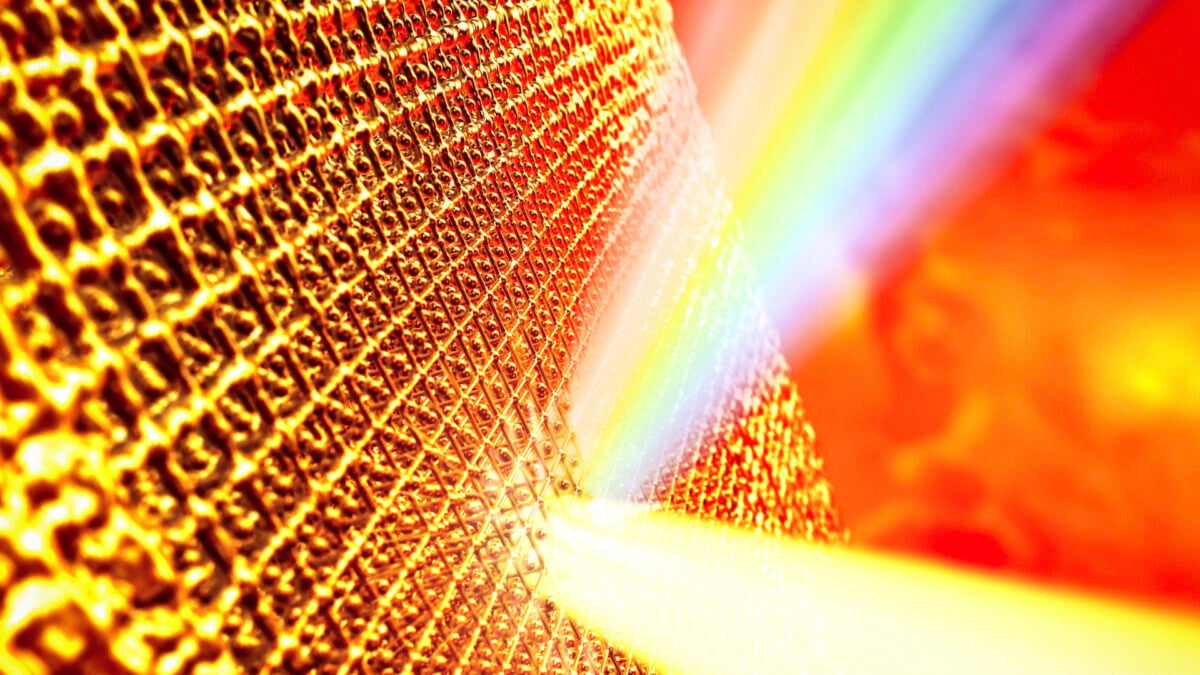
Scientists outfitted with big lasers have blown up gold at SLAC National Accelerator Laboratory, heating it to 14 occasions its boiling level. For a chilling second, they thought they broke physics, however they fortuitously did no such factor. That mentioned, they broke one thing else: a decades-long mannequin in bodily chemistry having to do with the basic properties of matter.
In an experiment introduced right this moment in Nature, researchers, for the primary time ever, demonstrated a method to instantly measure the temperature of matter in excessive states, or circumstances with intensely excessive temperatures, pressures, or densities. Utilizing the brand new approach, scientists succeeded in capturing gold at a temperature far past its boiling level—a process referred to as superheating—at which level the frequent metallic existed in an odd limbo between strong and liquid. The outcomes recommend that, below the fitting circumstances, gold might haven’t any superheating restrict. If true, this might have a variety of purposes throughout spaceflight, astrophysics, or nuclear chemistry, in accordance with the researchers.
The examine is predicated on a two-pronged experiment. First, the scientists used a laser to superheat a pattern of gold, suppressing the metallic’s pure tendency to broaden when heated. Subsequent, they used ultrabright X-rays to zap the gold samples, which scattered off the floor of the gold. By calculating the distortions within the X-ray’s frequency after colliding with the gold particles, the workforce locked down the velocity and temperature of the atoms.
The experimental end result seemingly refutes a well-established theory in physics, which states that buildings like gold can’t be heated greater than thrice their boiling level, 1,948 levels Fahrenheit (1,064 levels Celsius). Past these temperatures, superheated gold is meant to succeed in the so-called “entropy disaster”—or, in additional colloquial phrases, the heated gold ought to’ve blown up.
The researchers themselves didn’t count on to surpass that restrict. The brand new end result disproves the traditional concept, but it surely does so in a giant manner by far overshooting the theoretical prediction, exhibiting that it’s potential to warmth gold as much as a jaw-dropping 33,740 levels F (18,726 levels C).
“We regarded on the knowledge, and anyone simply mentioned, ‘Wait a minute. Is that this axis appropriate? That’s…actually sizzling, isn’t it?” Thomas White, examine lead creator and physicist on the College of Nevada, Reno, recalled to Gizmodo throughout a video name.
To be honest, this superheated state lasted for a mere a number of trillionths of a second. Additionally, it blew up. However that’s nonetheless “lengthy sufficient to be attention-grabbing,” White mentioned, including that “when you may stop it from increasing, [theoretically speaking] you possibly can warmth it eternally.” To which he added: “I’m very grateful that I get to blow stuff up with big lasers for discoveries. And that’s my job, you already know.”
This conjecture should face up to follow-up experiments with each gold and different supplies, White famous. However from a sensible standpoint, the superheated gold saved itself collectively lengthy sufficient such that the workforce was capable of instantly seize its temperature utilizing their new approach, Bob Nagler, examine senior creator and workers scientist at SLAC, defined to Gizmodo in a video name.
“Really, it’s a humorous factor; temperature is likely one of the bodily portions that people have recognized for the longest time—however we don’t measure temperature itself,” Nagler mentioned. “We measure one thing that temperature influences. For instance, a mercury thermometer measures how temperature adjustments the quantity of a blob of mercury.”
This might pose an issue when learning some real-life examples of sizzling, dense matter in excessive states, akin to the center of a star, the nose cone of a spaceship, or the insides of a fusion reactor. Realizing the temperature—a basic bodily property—of matter in such conditions may enormously inform how we examine or, for the latter two, manipulate them to our profit.

Typically, nevertheless, these programs function on temperature-dependent variables which can be tough to gauge, Nagler mentioned. Technically, you possibly can reproduce them in labs, however they’ll “in a short time explode,” he famous—however the truth that you’d nonetheless should know the real-life temperature of the system being replicated to make sure the experiments are legitimate.
“So you will have a chicken-and-egg drawback,” he mentioned. That’s why the scientists are keen to examine how their new approach may assist on this regard.
“That’s probably the most thrilling factor about this work—we now have a thermometer for all these loopy experiments we’ve been doing,” White mentioned. For instance, the Nationwide Ignition Facility on the Lawrence Livermore Nationwide Laboratory uses a gold cylinder to contain their nuclear fusion experiments, firing X-rays at this cylinder to drive the fusion reactor, White defined.
“However we’re additionally considering of doing instantly fusion-related experiments now,” he mentioned. “To recreate fusion circumstances, or the supplies that make the fusion reactors, and simply measure their temperature—which, truly, has been a long-standing query [in physics].”
The workforce is already making use of the approach to different supplies, akin to silver and iron, which they fortunately report produced some promising knowledge. The workforce will likely be busy over the subsequent few months analyzing what these metals could possibly be telling us, the scientists mentioned. The undertaking, for certain, is in full ignition.
Trending Merchandise

NETGEAR 4-Stream WiFi 6 Router (R6700AX) – AX1800 Wi-fi Pace (As much as 1.8 Gbps) | Protection as much as 1,500 sq. ft., 20 gadgets

CHONCHOW LED Keyboard and Mouse, 104 Keys Rainbow Backlit Keyboard and 7 Color RGB Mouse, White Gaming Keyboard and Mouse Combo for PC Laptop Xbox PS4 Gamers and Work

HP Portable Laptop, Student and Business, 14″ HD Display, Intel Quad-Core N4120, 8GB DDR4 RAM, 64GB eMMC, 1 Year Office 365, Webcam, RJ-45, HDMI, Wi-Fi, Windows 11 Home, Silver












